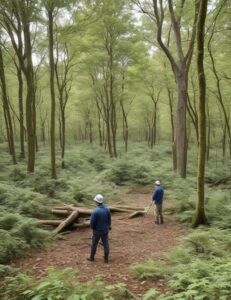Embracing Sustainable Forestry
Woodland management often centered around extraction, focusing on maximizing yields without much regard for long-term environmental consequences. A paradigm shift is underway. The future of woodland management lies in sustainability, where ecosystems are not just preserved but nurtured, ensuring a balance between human needs and ecological harmony.
Foresters and conservationists are no longer adversaries but allies. Through meticulous planning and thoughtful practices, they ensure that every tree felled is replaced, every ecosystem preserved, and every creature within the woodlands allowed to thrive.
By embracing sustainable forestry, we safeguard the very air we breathe and the water we drink. We pave the way for a future where lush forests act as lungs for our planet, absorbing carbon dioxide and replenishing the atmosphere with life-enabling oxygen.
 Precision Forestry
Precision Forestry
Thanks to Geographic Information Systems (GIS) and the remarkable capabilities of LiDAR technology, our woodlands are being transformed into three-dimensional landscapes of data. This technological marvel allows foresters to peer into the heart of the forest, understanding its topography, the health of its trees, and even the density of its foliage.
Foresters with such detailed information can now make decisions with accuracy. They can identify the perfect candidates for harvesting, ensuring that the process is not only efficient but also sustainable. Trees that are vital to the ecosystem can be preserved, their roles as habitat providers and soil stabilizers safeguarded.
Precision Forestry minimizes waste. Every log harvested is chosen deliberately, reducing unnecessary felling and ensuring that the woodlands remain vibrant and resilient. It’s about the quality of our forestry practices, elevating them to an art form where every action is purposeful and every outcome is beneficial.
IoT in Woodland Management
Smart sensors placed strategically throughout the forest provide real-time data on soil quality, moisture levels, and tree health. This data is invaluable, enabling foresters to make informed decisions promptly. Smart forests also facilitate early detection of diseases and pests, averting potential disasters and ensuring the overall health of the ecosystem.
It enables us to be proactive custodians of nature. These sensors can detect subtle changes in the environment, often harbingers of larger ecological shifts. An unexpected drop in soil moisture might indicate a looming drought, prompting timely intervention to protect vulnerable plants and animals.
Smart Forests empower us to combat threats before they escalate. Early detection of diseases or pests can be the difference between a thriving ecosystem and one in peril. The IoT devices provide us with the eyes and ears needed to identify these threats swiftly, allowing us to take precise, targeted actions, minimizing damage and preserving the woodland’s health.
Bioinformatics and Genomics
By understanding the genetic makeup of trees at a profound level, scientists can pinpoint specific genes that confer resilience against diseases, pests, and the challenges of climate change. These genetically enhanced trees not only ensure a more robust woodland ecosystem but also offer higher-quality timber, thus reducing the need for constant deforestation.
Genomics is the intricate art of manipulating these genetic codes. Through careful selection and advanced breeding techniques, scientists can enhance desirable traits in trees, creating species that are not only hardy and disease-resistant but also yield high-quality timber. You can make forests where trees are not just randomly scattered entities, but carefully designed components of a resilient ecosystem.
The implications of Bioinformatics and Genomics in forestry are profound. They pave the way for creating forests that are tailor-made for the future. Trees that can withstand droughts, resist diseases, and sequester more carbon dioxide, thereby mitigating the effects of climate change.
Circular Economy and Woodland Management
In the future, woodlands will play a pivotal role in the circular economy, where resources are reused, recycled, and repurposed. Wood, a renewable resource, can be used for more than just construction and paper. Innovative applications such as sustainable biofuel production, carbon-neutral packaging materials, and even eco-friendly textiles are emerging. This shift towards a circular economy ensures that every part of the tree is utilized, minimizing waste and promoting sustainability.
The Circular Economy also champions the concept of biomass utilization. Instead of viewing dead trees and plant materials as mere debris, they are seen as valuable resources. Biomass can be converted into bioenergy, serving as a renewable fuel source and reducing our reliance on fossil fuels. Additionally, it can be transformed into biodegradable products, closing the loop of sustainability and minimizing our environmental footprint.
We are recognizing that our actions can either deplete or enrich the natural world. With every recycled product, every repurposed resource, we are not just conserving – we are regenerating, breathing new life into the heart of our woodlands.
Cultivating a Sustainable Coexistence
Amidst the advancements in woodland management, one innovative approach stands out: Agroforestry, a harmonious blend of agriculture and forestry. In this practice, trees and crops coexist, benefiting from each other’s presence.
Trees provide shelter, conserving soil moisture and offering protection from harsh weather. Their fallen leaves become natural fertilizer, enriching the soil and enhancing crop yields. Crops contribute to the ecosystem by preventing soil erosion, providing natural pest control, and creating a diverse, sustainable agricultural system.
This approach promotes biodiversity and mitigates the impact of climate change. It’s about cultivating a symbiotic relationship between humanity and the environment, where both flourish in tandem.
Community Engagement and Conservation
A future-focused approach to woodland management must incorporate the wisdom of local communities and indigenous peoples. Their traditional knowledge, passed down through generations, is invaluable in understanding the delicate balance of woodland ecosystems. They understand the rhythms of nature, the migration patterns of animals, and the healing properties of plants. Engaging with these communities not only preserves cultural heritage but also promotes sustainable practices that have stood the test of time.
Community engagement fosters a sense of ownership. When people actively participate in conservation efforts, they become guardians of the forest. Children grow up learning the importance of nurturing nature. Adults take pride in the sustainable practices they adopt. This collective consciousness protects woodlands from illegal activities, deforestation, and pollution.